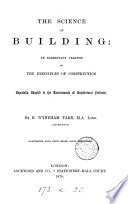 | Isaac Todhunter - 1853 - 362 pages
...is evident that the resulting force is equal to their sum, and acts in the same direction. When two forces act in different directions, but in the same straight line, on a particle, it is equally clear that their resultant is equal to their difference, and acts in the direction of... | |
 | William Guy Peck - 1859 - 368 pages
...resultant is equal to the sum of the two forces. If they act in contrary directions, their resultant is equal to their difference, and acts in the direction of the greater one. In general, if any number of forces are applied at the same point, some of which act in one direction,... | |
 | Isaac Todhunter - 1866 - 386 pages
...is evident that the resultant force is equal to their sum and acts in the same direction. When two forces act in different directions, but in the same straight line, on a particle, it is equally clear that their resultant is equal to their difference and acts in the direction of... | |
 | John Kerr - 1866 - 358 pages
...in the same direction, their resultant is equal to their sum; if they act in contrary directions, it is equal to their difference, and acts in the direction of the greater. AXIOM 5. Two equal forces balance one another, if they act upon two points of a rigid body along the... | |
 | Isaac Todhunter - 1867 - 368 pages
...in the same direction. 26. When two forces act on a particle in opposite directions their resultant is equal to their difference, and acts in the direction of the greater force. This is obvious. For example, if a force of 5 lbs. and a force of 3 lbs. act on a particle in... | |
 | Isaac Todhunter - 1867 - 372 pages
...in the same direction. 26. When two forces act on a particle in opposite directions their resultant is equal to their difference, and acts in the direction of the greater force. This is obvious. For example, if a force of 5 Ibs. and a force of 3 Ibs. act on a particle in... | |
 | Richard Wormell - 1869 - 270 pages
...F'. Therefore the resultant of two unlike parallel forces acting on a solid body at points A and в is equal to their difference, and acts in the direction of the greater, through a point с in the line А в produced on the side of the greater force such that F : F :: OB... | |
 | Edward Wyndham Tarn - 1870 - 170 pages
...If the forces P and Q act in opposite directions (fig. 6) (Q, being greater than P) the resultant E is equal to their difference and acts in the direction of the greater force at a point C, determined as before by the equation, P x AC = Q x BC, Q or AC = TT — -px AB.... | |
 | J W. Mulcaster - 1871 - 242 pages
...acts m the same direction. (ii) When two forces act on a body in different directions, the resulting force is equal to their difference, and acts in the direction of the greater. (iii) The effect of a force upon a body remains unaltered at whatever point in its direction it is... | |
 | Richard Wormell - 1871 - 288 pages
...equal to p — F' at a point c, such that, (F — F)-CA = F'AB or F'AC = FC B body at points A and B is equal to their difference, and acts in the direction of the greater, through a point c in the line AB produced on the side of the greater force, such that P : F : : CB... | |
| |